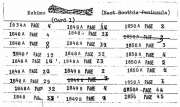
Andrew Taylor 1907-1993

William "Skip" Koolage, PhD.
Arctic/Subarctic Research
134 University College
arcticbb@cc.umanitoba.ca

Andrew's Index Cards

Andrew Taylor 1907-1993 |

William "Skip" Koolage, PhD. Arctic/Subarctic Research 134 University College arcticbb@cc.umanitoba.ca |

Andrew's Index Cards |
Welcome to the Arctic Blue Books online -- a searchable, World-Wide Web version of Andrew Taylor's unique index to the 19th Century British Parliamentary Papers concerned with the Canadian Arctic. The Index to the Arctic Blue Books by Andrew Taylor (1907-1993), O.C., B.Sc. (CE), M.A., Ph.D., D.Sc. was annotated, revised and digitized by the Arctic Blue Books Project, Arctic/Subarctic Research. This group also included Ruth May, MLS; Deborah Woodman, M.A.; Harpa Isfeld, M.A.; William O. Pruitt, Jr., Ph.D.; and Michael Angel, Ph.D. Arctic/Subarctic Research has placed this index and copies of the Blue Books in Archives and Government Documents, Elizabeth Dafoe Library; The Hudson's Bay Company Archives; and the Neil John MacLean Health Sciences Library.
Introduction and Acknowledgments
In 1998, the Index went on-line on the University of Manitoba's Libraries Homepage through the assistance of Jonathan Esterhazy, Libraries. Earlier paper drafts of the Index had been provided to Archives and Government Documents so that students and researchers could use the Blue Books.
In August 1998, Harpa Isfeld completed the final formatting of the Index through the four programs (MS Word, Hypercard, Filemaker, and Pagemaker) to produce a final printed copy of the Index. Theodore Macfarlane, Campus Copy Centre, engineered the printing of 3 copies of the 957 page Index to the Arctic Blue Books by Andrew Taylor. Siobhan Kari and Harpa Isfeld helped with post annotation production. Many thanks to Lynne Dalman and Brian Schwimmer for placing this on the Anthropology website.
Despite the best efforts of Hoodoo, Snafu, Murphy, and Sod, the Index is now on-line at the University of Manitoba Libraries homepage and in print format. We survived two floods and a mess of other hassles in completing Andrew's amazing work of many years ago. Thank you all for your help.
Skip Koolage 1998
Where are the Arctic Blue Books?
Other source materials relevant to the era and area of the Arctic Blue Books.
Taylor's primary works on the Arctic are Geographical Discovery and Exploration of the Queen Elizabeth Islands and The Physiography of the Queen Elizabeth Islands. Pierre Berton's The Arctic Grail is a good popular account of the era and the men and woman (Lady Jane Franklin) who played such prominent roles in the European exploration of northern North America. Leslie Neatby's Search for Franklin, In Quest of the North West Passage, and Frozen Ships, are excellent standard references. Patricia Sutherland's The Franklin Era in Canadian Arctic History 1845 -1859 (Ottawa: National Museum of Man Mercury Series No. 131, 1985) provides 16 eclectic essays on this subject. For Alaskan Native villages, see Dorothy Jean Ray's "Ninetieth Century Settlement and Subsistence Patterns in Bering Strait" in Arctic Anthropology 1964: 2.2 pp. 61-97.
Arctic Council high level intergovernmental forum that provides a mechanism to address the common concerns and challenges faced by Arctic governments and people.
The Arctic Institute of North America nonprofit and multidisciplinary organization seeking to advance the study of Canada's North through the natural and social sciences, the arts and humanities; and to disseminate information on physical, environmental and social conditions in the North.
Arctic Studies Center at the National Museum of Natural History of the Smithsonian Institution.
Circumpolar Universities Association organ for cooperation between institutes of higher learning and research in the northern circumpolar region of the world.
Northern Forum organization made up of national governments and businesses in the world's northern regions.
Polar Web Polar internet resource guide
Arctic Dawn Originally published in 1795, this is a new hypertext edition of the journals of Samuel Hearne, the first European to explore the western Canadian Arctic. Includes pictures and sounds.
Center for Global Change and Arctic System Research studies physical, biological and social processes of the Arctic that interact with the Earth system, and their relationship to global change.
Canadian Arctic Resources Committee national public interest organization, registered charity, involved in researching, publishing, public advocacy, litigation, in accord with Arctic environmental and cultural sustainability.
Archaeology in Arctic North America
Arctic Centre research and information on the Arctic.
McDougall Sound Archaeological Research Project virtual slide show based upon archaeological research carried out in the Canadian High Arctic chronicles the Dorset culture.
Churchill Northern Studies Centre a non-profit educational organization with a mandate to facilitate arctic research.
Polar Museums Directory provides brief details of museums known to have collections relating to the Arctic and Antarctic.
The Franklin Trail Homepage Archaeological survey of the Franklin Expedition